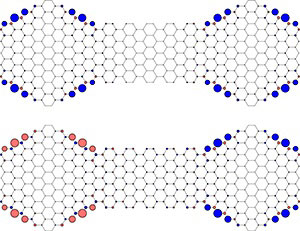| Nov 21, 2011 |
Spintronics: Graphene makes the switch
|
|
(Nanowerk News) Spin valves are one of the basic building blocks of spintronics, allowing a signal to be processed using magnetic spin properties rather than electronic charge. A theoretical study by Zhaoli Ma and Weidong Sheng from Fudan University in China now suggests that nanosized ribbons of graphene could potentially be used to create spin valves ("A spin-valve device based on dumbbell-shaped graphene nanoislands").
|
|
The spin valve technology is highly efficient and sensitive, and has found uses in advanced applications such as in the read heads of hard disk drives. The 'valves' consist of two magnetic layers separated by a non-magnetic spacer, giving the device a strong resistance response to the relative alignment of the spins in the two magnetic layers — a parallel alignment favors the unimpeded transport of electrons, whereas an antiparallel alignment blocks electron transport, providing the on–off states of the spin valve.
|
 |
| Calculated spin configurations in the on (upper) and off (lower) states of a graphene nanoribbon-based spin valve. (© 2011 AIP)
|
|
Graphene sheets have a range of highly useful mechanical, electronic and thermal properties, many of which arise from the material's two-dimensional structure. At the edges, however, the carbon atoms that make up the honeycomb lattice of graphene can form zig-zag or armchair patterns that profoundly affect the conductive properties of graphene when cut into narrow nanoribbons. Electrons at the edges of zig-zag nanoribbons in particular have been shown to be spin polarized.
|
|
Ma and Sheng theoretically designed a spin valve exploiting these intrinsic properties of graphene nanoribbons. The suggested device structure (see image) has two hexagonal graphene nanoislands with zig-zag edges, which serve as the magnetic layers in the spin valve, connected by an armchair-type nanoribbon as the non-magnetic layer, through which the electrons can pass depending on the relative alignment of the spins in the nanoislands.
|
|
The researcher's calculations show that stable spin configurations emerge at certain energies, and specifically that there exist stable configurations in which the islands are polarized either parallel or antiparallel with respect to each other — a necessary requirement for a spin valve. The accompanying electron transport calculations demonstrate that the spin-anti-aligned islands do not allow electrons to pass through the device, whereas the spin-aligned islands do, and that the required on–off states of a spin valve can be defined.
|

